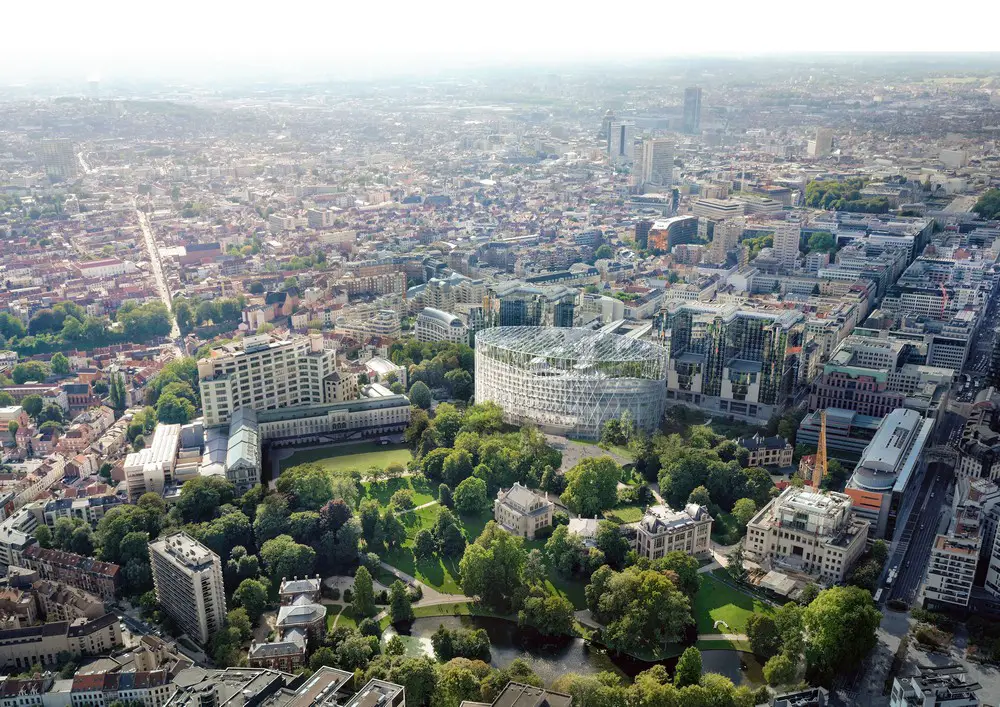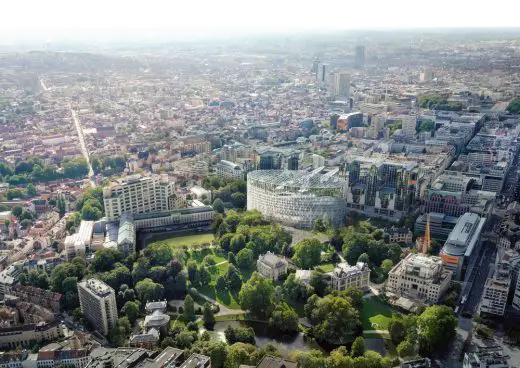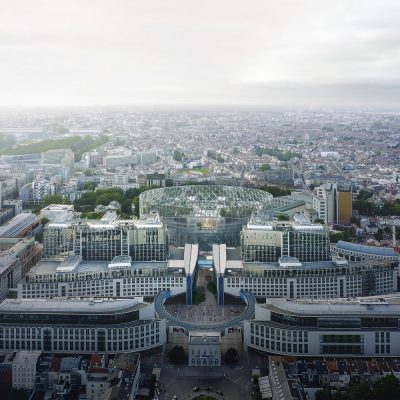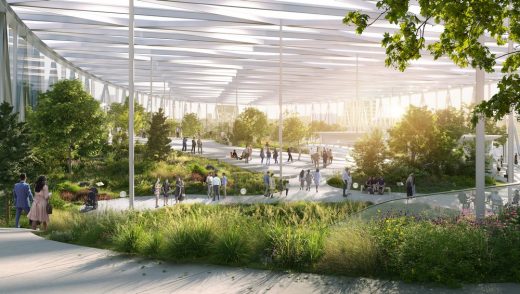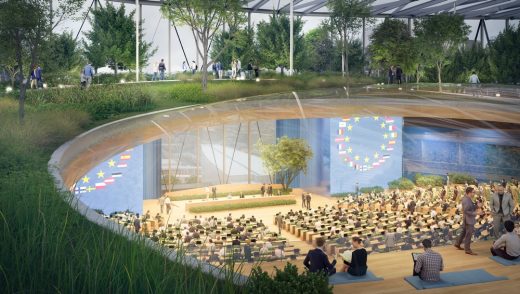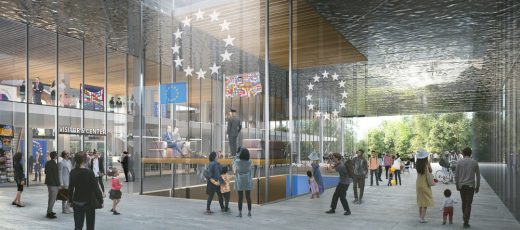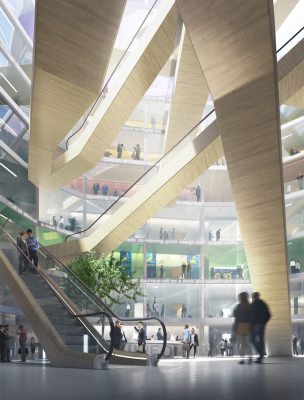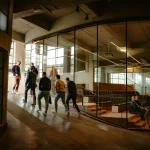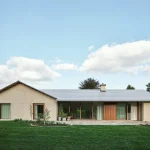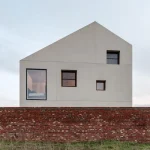Renewed European Parliament Brussels, Paul-Henri SPAAK Building transformation, Belgian architecture images
Renewed European Parliament Building in Brussels
17 Nov 2022
Design: JDSA
Location: Brussels, Belgium, Europe
Images: Corrected Verticals
Renewed Paul-Henri SPAAK Building, Belgium
A pan-European design collective has won the international competition organized by the European Parliament to renew the Paul-Henri SPAAK Building in Brussels, Belgium. The proposal underscores the identity of the European Union and the value of democracy, while promoting the principles of circular construction.
“With a war on the doorstep of Europe, and an ensuing energy crisis ever more pressing, the challenges faced by the European Union are shared by us all. As a team of Pan-European offices composed of more than 30 nationalities, we understand and feel the impact of these difficulties directly.
Our collective proposal to rethink the Parliament building in a way that minimizes environmental impact while expanding its openness and civic inclusion as embodiments of the values of European democracy are therefore evermore relevant.”
EUROPARC (collective JDSA-Coldefy-CRA-NL-ENSAMBLE)
The Proposal
The current SPAAK building has numerous shortcomings. However demolishing it and replacing it with a new ‘palace’ might be the wrong approach.
In the building sector, over 50% of the carbon footprint generated happens in constructing the raw structure of a building. If fully dismantled, all that expense is lost and needs to be spent again in a new construction. Here, the strategy should be to rigorously re-use most of the SPAAK structure, its carbon expense. Furthermore, the design strategy offers to significantly improve the Parliament’s working conditions and catalyze the potential for communication and exchange with European citizens while keeping as much of the existing structure as possible.
Connection to the City
On an urban scale, the design by EUROPARC aims to strengthen the linkage between the building and the city. By opening up the block, it enhances the continuity of pedestrian flows in the area and creates a stronger connection between Place du Luxembourg and Parc Léopold. The public realm is expanded both inside and outside the architecture, creating a more welcoming experience for the citizens and visitors of Brussels.
The building should not be impenetrable, but should be a place of openness. Therefore, a public passage could be created through the Parliament. In a natural and intuitive way the passage will provide a grand entrance to visitors of the Parliament and establish an actual node in the pedestrian network of Brussels. Additionally a magnificent found quality can be activated by excavating the Spinelli building in front, on the axis from Gare d’Europe. By removing the wall-like condition in this central part of the building a truly inviting gesture comes into being: instead of obstructing the Spaak, the Spinelli now becomes an open-air entrance to the Parliament, quite literally welcoming the public with open arms.
The Hemicycle
The new assembly chamber of the European Parliament, called the Hemicycle, will be repositioned on the upper levels of the renewed building to meet the spatial requirements for a modernized chamber. It will be equipped with digital amenities that help spread the discourse of democracy beyond physical confines. The room is extensively integrated with the Parliament’s digital platform to enhance transparency and encourage external participation. Another primary feature is the large windows which establish a visual dialogue between the Parliament, the rooftop garden, as well as the city and European citizens at large. One of these large windows can also become a screen to transmit information in real time during assemblies.
The Green Agora
Located on the highest floor, the Green Agora is the culmination of the public visitors’ journey in the building. The botanical garden draws inspiration from the “agora” in Ancient Greece – it literally means “gathering place” and facilitated the circulation of ideas among people at the time. Not only visually connected to the Hemicycle through the latter’s open ceiling, the Green Agora will also serve as the beacon of European democracy, where citizens and the Members of the European Parliament meet and exchange thoughts. In addition, the spirit of pan-European synergy is reinforced in natural terms, as the park brings together vegetation indigenous to all the member states to form a multifaceted European ecosystem.
All in all, the new SPAAK building by EUROPARC – with the permeable ground floor, the Hemicycle, the Green Agora and beyond – creates a civic ecosystem that places people at the center of the spatial experience and brings them closer to the democratic processes of Europe. It is a unique piece of infrastructure that gives the Members of the European Parliament the space to carry out their parliamentary missions and citizens access to a site of significant political and social value to enrich their everyday life.
The Team
EUROPARC, a design collective made up of five architectural studios from five European countries, won the international competition to design the new European Parliament building. The collective’s winning proposal focuses on the renewal of the Paul-Henri SPAAK Building in Brussels, in accordance with a circular approach to minimize waste. In addition, it honors European democracy, most notably through the collective’s international makeup, and the many public areas accessible to all people.
EUROPARC is composed of architectural studios JDSA / Julien De Smedt Architects (DK/BE), Coldefy (FR), CRA
-Carlo Ratti Associati (IT), NL Architects (NL) and Ensamble Studio (SP), with the support of engineering companies from UTIL (BE) and Ramboll (DK).
Together, these teams account for over 30 different nationalities in their ranks. The collective formation emphasizes a new approach to architecture, one that prioritizes collaboration and orchestrates the know-how of different disciplines, instead of relying on individualism and singular decision-making, a common practice in the past century.
The team engaged in a creative process which embodies the democratic ideal of the European Union. All the members, drawing inspiration from their respective cultural backgrounds and distinct specialties, worked together to put forward a collective design solution for the European Parliament building. The design seeks to address urgent challenges faced by Europe and the world at large, including climate change, social inequalities and the blurring of physical and digital domains – the latter is also reflected in the collective’s mode of collaboration, where a remote and flexible approach was adopted since the first COVID-19 outbreak. The European Parliament announced the international competition to renew the SPAAK Building in May 2020, with the objectives to set a positive example of sustainable and regenerative building, and to engage in dialogue with citizens and the city. EUROPARC’s proposal stood out from the 15 submitted designs, and was officially named the winner of the first prize in July 2022. The jury commended the project for both its functional and symbolic qualities, calling it “… a genuine re-use proposal that offers an enhanced interface with the public and a new architectural expression to the building with useful sustainability features.”
The Competition
The procedure was held in two steps, initially as an open pre-qualification procedure for the selection of competitors among candidates and followed by a restricted single stage anonymous design competition conducted according to the UNESCO Standard Regulations for International Competitions in Architecture and Town Planning and the UIA (International Union of Architects) best practice recommendations.
The competition is endorsed by the Union Internationale des Architectes (UIA) – https://www.uia-architectes.org/en/.
1st prize
JDS Architects (Denmark) – http://jdsa.eu/
Coldefy (France) | NL Architects (Netherlands) | Carlo Ratti Associati (Italy) | ENSAMBLE STUDIO (Spain) | UTIL cvba (Belgium) | Ramboll (Denmark)
2nd prize
JABORNEGG & PALFFY Generalplaner ZT GmbH (Austria)
KUEHN MALVEZZI (Germany) | AXIS Ingenieurleistungen ZT GmbH (Austria)
3rd prize
MOREAU KUSUNOKI (France)
Dethier Architectures (Belgium) | sbp france (France) | ME Engineers Ltd (United Kingdom)
4th prize
BELVEDERE ARCHITECTURE (France)
Ove Arup & Partners International Ltd (United Kingdom)
5th prize
A2M (Belgium)
VK ENGINEERING (Belgium) | C.F. Møller Architects (Denmark)
Other entrants (alphabetical order):
Baumschlager Eberle Architekten (Liechtenstein)
Bureau Bouwtechniek (Belgium) | Macobo-Stabo (Belgium)
Cobe A/S (Denmark)
Lundgaard & Tranberg Arkitekter A/S (Denmark) | Steensen Varming (Denmark) |
Tyréns AB (Sweden)
Dominique Perrault Architecte (France)
Ney & Partners – T6 S.à r.l. (Luxembourg) | Jean-Paul LAMOUREUX (France) | HL-PP Consult International Ingenieurgesellschaft mbH (Germany) | URBAN ECO SCOP (France) | DDS+ (Belgium) | Arcora (France) | Gaëlle Lauriot-Prévost (France) | SORANE SA (Switzerland)
Helin & Co Architects (Finland)
Sitowise Oy (Finland) | LPR-architects (Finland)
KAAN Architecten (Netherlands)
DGMR Bouw B.V. (Netherlands) | SVR-ARCHITECTS nv (Belgium) | Werner Sobek Frankfurt (Germany)
Neutelings Riedijk Architecten B.V. (Netherlands)
NEY & Partners WOW bvba (Belgium) | BSEG (Belgium)
Office for Metropolitan Architecture (O.M.A.) Stedebouw B.V. (Netherlands)
studiebureau r. boydens nv (Belgium) | Ney & Partners BXL nv (Belgium)
Renzo Piano Building Workshop (France)
Happold Ingenieurbüro GmbH (Germany)
Shigeru Ban Architects (Japan)
Jean de Gastines Architectes (France) | Ove Arup and Partners Japan Ltd (Japan)
Snøhetta Oslo AS (Norway)
HL-Beratungs-u. Beteiligungs Gmbh (Germany) | BURO II & ARCHI+I (Belgium) | Bollinger + Grohmann Ingeniører AS (Norway) | SuReal (Belgium)
Renders: Corrected Verticals
Renewed European Parliament Building, Brussels images / information received 171122
Location: Brussels, Belgium, western Europe
Architecture in Belgium
Brussels Architectural Tours – Belgian capital city walks by e-architect
Major recent Belgian building on e-architect:
Port House, Antwerp
Design: Zaha Hadid Architects
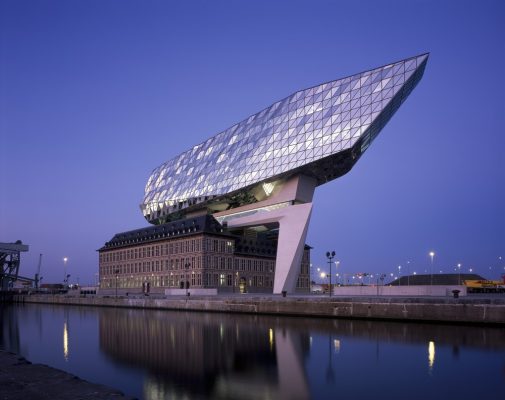
photo © Helene Binet
Recent Architecture in the Belgian Capital
Design: Vincent Callebaut Architectures
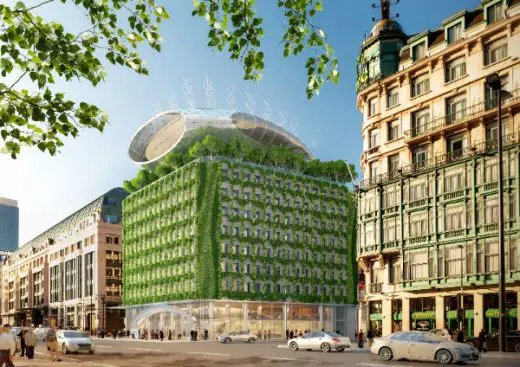
image from architect
Botanic Center Brussels Building
Design: UNStudio, Architects
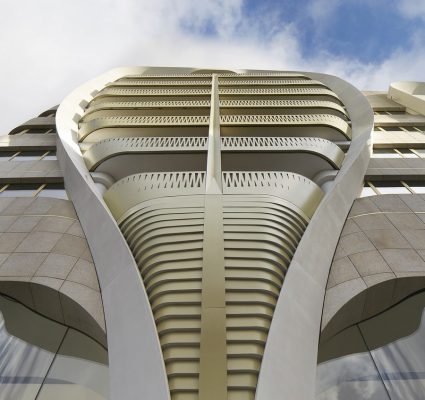
photography © Hufton+Crow © Eva Bloem
Le Toison d’Or Brussels Building
Comments / photos for the Renewed European Parliament Building, Brussels building design by Ohra Studio page welcome

